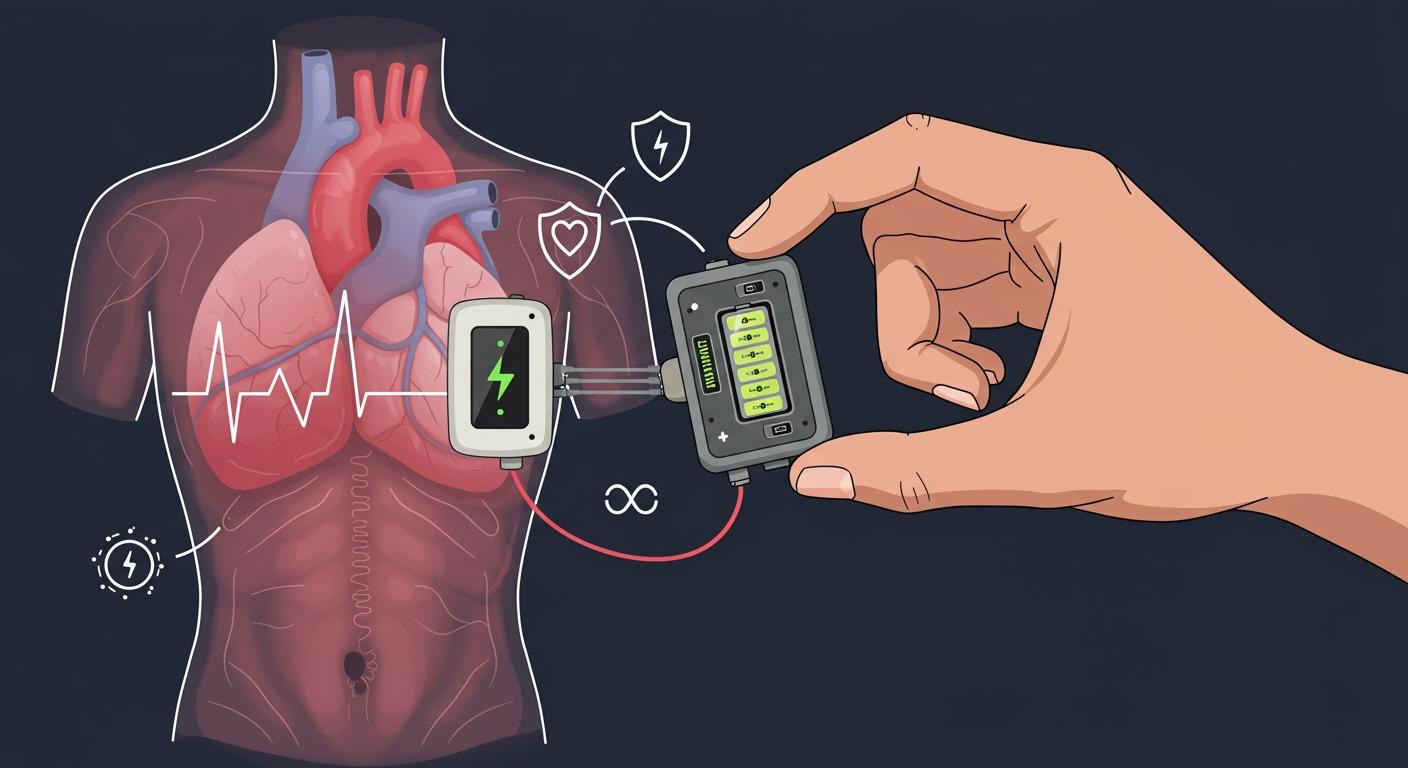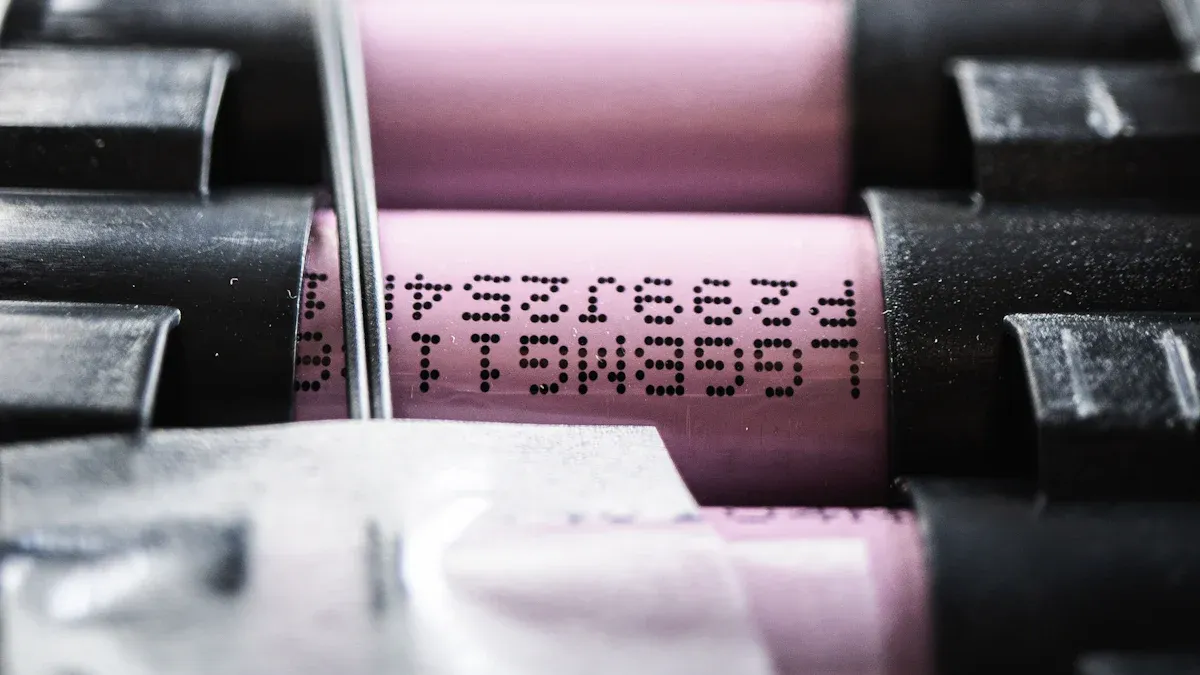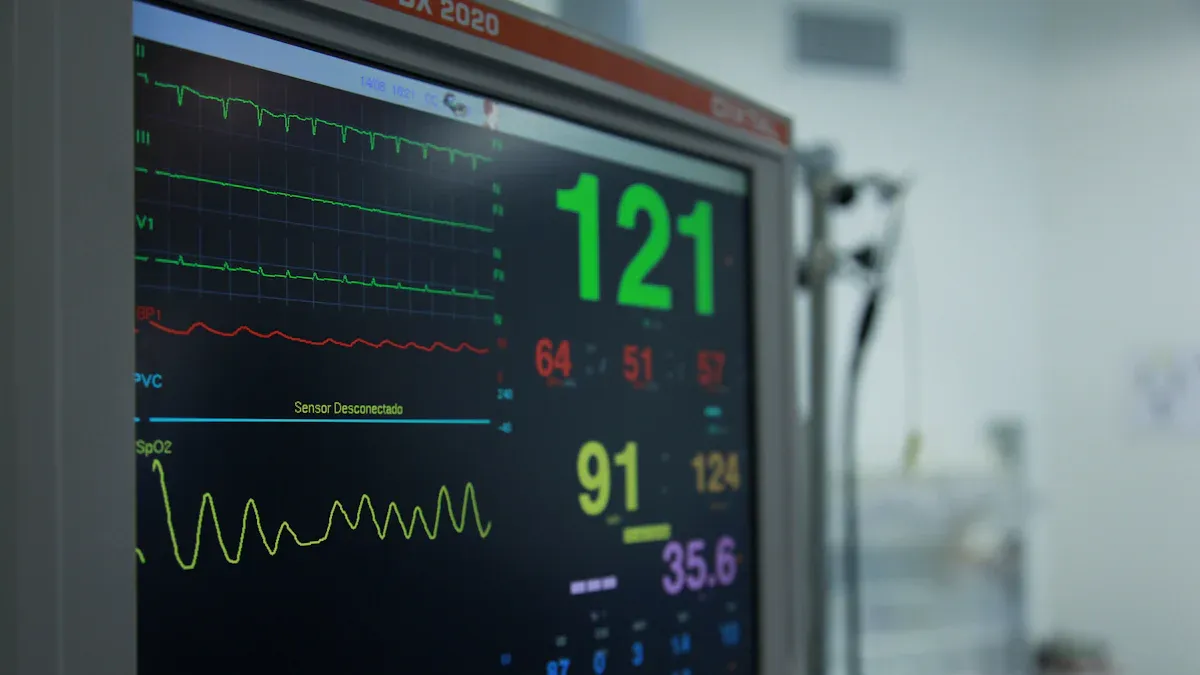
Cardiac devices depend on lithium batteries for reliable power and long-term stability. You can trust these batteries to deliver consistent energy in life-saving equipment. Lithium batteries support a wide temperature range and use hermetic sealing to protect sensitive cardiac technology. Their rechargeable design and low self-discharge rates help maintain performance for years. The first lithium-powered pacemaker appeared in 1972, showing the safety of this technology.
Here is a look at the average lifespan of lithium batteries in cardiac devices:
Device Type | Estimated Lifespan (Years) | Median Longevity (Years) |
|---|---|---|
Single-chamber ICDs | 8 to 10 | 11.0 |
Double-chamber ICDs | 6 to 9 | 8.5 |
Overall Battery Longevity | N/A | 10.8 |
Lithium-ion batteries are rechargeable and use metallic lithium ions bonded to carbon.
They offer high energy density and efficient energy transfer for cardiac devices.
Key Takeaways
Lithium batteries provide reliable power for cardiac devices, ensuring consistent energy delivery that is crucial for patient safety.
These batteries have a long lifespan, reducing the need for frequent replacements and minimizing surgical interventions for patients.
Low self-discharge rates in lithium batteries keep devices ready for use, enhancing operational efficiency and reliability over time.
Hermetic sealing in lithium batteries protects against moisture and contaminants, improving safety and extending battery life in medical applications.
Advanced safety features in lithium battery packs, such as gas sensors and protection circuits, ensure the highest standards of safety for cardiac devices.
Part 1: Lithium Batteries and Stable Performance

1.1 Power Delivery
You rely on lithium batteries to deliver reliable power to cardiac devices. These batteries provide a steady and predictable energy output, which is essential for devices like leadless pacemakers and implantable cardiac defibrillators. Unlike traditional chemical batteries, lithium-powered cells maintain consistent power delivery throughout their lifespan. This ‘always-on’ feature ensures uninterrupted device function, supporting long-term operation and patient safety.
Consistent power output is critical for cardiac devices. Tritium-powered batteries, such as those introduced by City Labs, offer predictable performance under different conditions. You can trust these batteries to keep cardiac devices running without sudden drops in energy.
Lithium battery chemistries offer high energy density and efficient energy transfer. The lithium/silver vanadium oxide cells used in implantable cardiac defibrillators undergo rigorous qualification and manufacturing controls. These processes result in a maximum random failure rate of only 0.005% per test month, which supports the reliability of cardiac devices over time.
Battery Chemistry | Energy Density (Wh/kg) | Application Scenario | Failure Rate (%) |
|---|---|---|---|
Lithium/Silver Vanadium Oxide | 200 | Medical (ICDs, pacemakers) | 0.005 |
Lithium-Ion | 250 | Medical, robotics, security | 0.18 (Abbott pacemakers) |
Tritium-powered | 150 | Medical (leadless pacemakers) | N/A |
You benefit from lithium batteries’ ability to serve as a backup power source, enhancing patient freedom and device reliability. These batteries support high power requirements (0.5–3 V) for advanced cardiac devices, such as LVADs and TAHs. Performance testing at 37°C cycling shows up to 2000 cycles, demonstrating their suitability for long-term operation in medical environments.
1.2 Reliability
Reliability stands at the core of cardiac device performance. You need batteries that operate across a wide temperature range and maintain their capacity in harsh environments. Standard lithium batteries function from -20°C to 60°C, while specialized chemistries extend this range even further.
Battery Type | Minimum Temperature | Maximum Temperature |
|---|---|---|
Standard Lithium Batteries | -20°C | 60°C |
Low-Temperature Lithium | -40°C | N/A |
High-Temperature Lithium | N/A | 85°C |
Lithium primary chemistries retain high capacity at low temperatures, delivering up to 110 mA h g⁻¹ at -20 °C and 50 mA h g⁻¹ at -40 °C. This performance under different conditions ensures that cardiac devices remain reliable, even in challenging medical environments.
Hermetic sealing plays a vital role in battery reliability and safety. You gain several advantages from this feature:
Hermetic sealing enhances battery performance by ensuring optimal power delivery and extending battery life.
Proper seals prevent energy loss, which is crucial for the longevity of batteries in cardiac devices.
The seals act as a barrier against moisture and contaminants, maintaining the integrity of batteries used in medical applications.
They protect against environmental stressors like temperature fluctuations and electrochemical reactions, reducing the risk of battery failure and safety hazards.
Clinical data supports the reliability of lithium batteries in cardiac devices. Abbott pacemakers report a failure rate of only 0.18%, with a mean implant duration at failure of 3.8 years. Rigorous performance testing and battery management systems further improve safety and reliability.
You can trust lithium batteries to deliver reliable power, maintain performance under different conditions, and support long-term operation in critical medical devices.
Part 2: Longevity of Cardiac Detection Devices

2.1 Battery Life
You depend on cardiac detection devices to monitor heart rhythms and deliver therapy over many years. Lithium batteries play a vital role in extending device lifespan and reducing the frequency of replacements. When you choose cardiac detection devices powered by lithium chemistries, you gain the advantage of extended battery life. This means fewer surgical interventions for battery replacement and less downtime for patients.
The chemistry and design of lithium batteries allow cardiac detection devices to operate reliably for up to a decade. You see this benefit in implantable cardiac monitors, pacemakers, and defibrillators. These devices require stable energy sources that can last for years without significant loss of capacity. Extended battery life supports continuous monitoring and therapy, which is essential for patient safety and device performance.
Battery Type | Typical Lifespan (Years) | Application Scenario |
|---|---|---|
Lithium/Silver Vanadium Oxide | 8–10 | Pacemakers, ICDs |
Lithium-Ion | 7–10 | Cardiac monitors, robotics, security |
LiSOCl2 (Superior Quality) | 10+ | AEDs, industrial sensors |
You benefit from standardized lithium battery chemistries that meet the demands of cardiac detection devices. These batteries offer high energy density, long shelf-life, and resistance to corrosion. You can rely on them for stable operation in medical, industrial, and infrastructure applications.
Tip: Extended battery life in cardiac detection devices means fewer replacements, lower maintenance costs, and improved patient outcomes.
2.2 Low Self-Discharge
Low self-discharge is a key feature that sets lithium batteries apart in cardiac detection devices. You need batteries that retain their charge over long periods, especially when devices remain idle or operate intermittently. Lithium batteries minimize energy loss, ensuring that cardiac detection devices stay ready for use whenever needed.
Lithium-ion batteries have a self-discharge rate of about 5% in the first 24 hours.
After this initial period, the rate drops to 1–2% per month.
Safety circuits add an extra 3% to the self-discharge rate.
At 40°C, self-discharge current can rise to 97 μA.
Low self-discharge rates help cardiac detection devices maintain operational efficiency and reliability. You see this advantage in devices like implantable loop recorders and external cardiac monitors. These devices must function accurately for years without frequent battery changes.
Characteristic | Description |
|---|---|
Voltage Characteristics | Meets minimum and maximum voltage requirements for reliable operation. |
Discharge Current | Supports initial, average, and maximum discharge currents for effective device function. |
Self-Discharge Rate | Low self-discharge maintains energy availability over long periods. |
Energy Density | High energy density minimizes size and weight of the battery. |
Longevity | Long shelf-life ensures reliability over the device’s operational period. |
Biocompatibility | Safe for use within the human body. |
Corrosion Resistance | Prevents degradation of battery materials over time. |
Hermetic Sealing | Prevents leakage and ensures safe operation within the body. |
Size and Weight | Lightweight and compact to fit within device constraints. |
Performance Under Varying Conditions | Operates effectively under different environmental conditions (temperature, pressure). |
You can compare battery types for cardiac detection devices by their self-discharge rates:
Battery Type | Self-Discharge Rate | Suitability for Cardiac Detection Devices |
|---|---|---|
LiSOCl2 (Superior Quality) | 0.7% annually | Ideal for devices that remain idle for years but must perform reliably when required. |
LiSOCl2 (Inferior Quality) | Up to 3% annually | Not suitable for critical applications due to higher energy loss over time. |
Rechargeable lithium-ion batteries offer additional benefits for cardiac detection devices. You gain safety, reliability, and high energy density. These batteries maintain their charge for extended periods and support long service life. Their compact size allows integration into small cardiac detection devices, supporting miniaturization and advanced medical technology.
Advantage | Description |
|---|---|
Safety | Designed to meet high safety standards. |
Reliability | Provides consistent performance over time. |
High Energy Density | Offers significant energy relative to size. |
Low Self-Discharge | Maintains charge for extended periods when not in use. |
Long Service Life | Lasts for years, suitable for long-term medical implants. |
Suitability for Miniaturization | Compact size allows integration into small medical devices. |
You see these advantages in cardiac detection devices used in medical, robotics, and security sectors. Rechargeable lithium-ion batteries support sustainability and long-term device operation. For more information on rechargeable capabilities and sustainability, you can refer to internal resources on advanced battery solutions.
Part 3: Lithium Battery Solutions for Cardiac Devices
3.1 Safety Features
You need lithium battery solutions that meet the highest standards for safety and compliance in cardiac applications. These batteries use advanced protection circuits to prevent overheating, short-circuiting, and overcharging. Hermetic sealing keeps out moisture and contaminants, which helps prevent leaks and ensures long-term reliability. You benefit from systems that monitor for gases like hydrogen and carbon monoxide. Real-time alerts and gas sensors allow you to detect potential leaks early and take immediate action. Emergency measures, such as activating ventilation or shutting off power, protect both patients and equipment.
Gas sensors monitor harmful gas concentrations to detect leakage risks promptly.
Systems issue warnings and activate emergency measures when gas levels exceed safety thresholds.
Continuous monitoring for gases enables early detection of potential leaks.
Lithium battery solutions for cardiac devices must also comply with strict regulatory standards, including ANSI/AAMI ES 60601-1, IEC 60086-4, and IEC 62133. These standards ensure that batteries meet rigorous requirements for medical safety and durability. Compared to older chemistries like Nickel-Cadmium or Lead Acid, lithium batteries provide superior performance and safety, which is essential for high-risk conditions. You can trust these batteries to deliver stable power for devices such as pacemakers and portable heart monitors.
3.2 Compact Design
You gain significant advantages from the compact and lightweight design of modern lithium battery solutions. Implantable cardiac devices require batteries that fit within small spaces while still delivering high energy density. For example, pacemaker batteries typically weigh 20-30 grams, while ICD batteries weigh 80–90 grams and have a volume of about 30 mL.
Device Type | Weight (g) | Volume (mL) |
|---|---|---|
ICD | 80–90 | 30 |
Pacemaker | 20-30 | N/A |
Most batteries have a diameter of 20-40 mm and a thickness of 3-6 mm. This compact size supports the miniaturization of cardiac devices, making them more comfortable for patients and easier to implant. You also see benefits in wearable ecg machines and continuous monitoring systems, where small, lightweight batteries enable portability and long-term use.
Benefit | Description |
|---|---|
Compact and Lightweight | LiPo batteries have a thin and flexible design, allowing for smaller devices. |
High Energy Density | These batteries store more energy in a smaller space, extending usage times. |
Long Lifespan | Fewer replacements needed, enhancing patient comfort and reducing surgeries. |
Stable Power Output | Ensures reliable performance for devices like pacemakers, improving patient safety. |
Biocompatible Materials | Safety in medical applications, reducing complications for patients. |
Lithium battery solutions also support wireless medical devices and remote monitoring. Manufacturers recommend remote monitoring as a key tool for early detection of battery-related issues, which improves device reliability and patient safety. You can rely on these batteries for continuous monitoring in advanced cardiac care, as they provide reliable long-term operation and durability in both hospital and home settings. Battery Management Systems (BMS) further enhance safety and performance by monitoring battery status and optimizing energy use. These solutions find applications not only in medical devices but also in robotics, security, infrastructure, and industrial sectors.
Part 4: Impact on Cardiac Care
4.1 Reduced Maintenance
You see a major shift in cardiac device management with advanced battery technology. Devices powered by lithium-iodine and lithium-ion chemistries offer longer lifespans, which means fewer surgical interventions and less frequent maintenance. You help patients avoid repeated procedures, lowering risks and improving outcomes for those with critical medical needs.
Device Type | Battery Type | Lifespan | Maintenance Requirement |
|---|---|---|---|
Implantable Devices | Lithium-iodine (Li-I₂) | 7-15 years | Surgery required for replacement |
External Devices | Lithium ion/polymer | 3-5 years | Regular maintenance needed |
You notice that implantable cardiac devices often last up to 15 years before needing battery replacement. This extended lifespan reduces the number of surgeries and hospital visits. You also benefit from lower maintenance costs and better scheduling for replacements.
Benefit | Description |
|---|---|
Reduced Downtime | Systems stay online longer, even during emergencies. |
Extended Battery Lifespan | Preventing overcharge and thermal damage increases battery cycles. |
Lower Maintenance Costs | Fewer emergency repairs and better replacement schedules save time and budget. |
A study found that battery malfunctions and discharge during treatments can compromise patient care. You improve patient safety by using advanced battery packs and monitoring protocols.
4.2 Quality of Life
You improve the quality of life for cardiac patients by choosing devices with reliable battery technology. Fewer surgeries mean less stress and faster recovery. Patients experience greater comfort and freedom, especially with lightweight and compact devices.
Evidence Type | Description |
|---|---|
Longevity and Safety Profile | Longer battery lifespan reduces the frequency of replacement surgeries, lowering risks. |
Lightweight Nature | Reduced weight enhances device maneuverability and patient comfort. |
Safety Features | Exceptional safety features minimize hazards, ensuring well-being and peace of mind for providers. |
You give healthcare professionals peace of mind. Reliable cardiac devices allow you to focus on patient care instead of emergency repairs. You trust the safety features and long-term stability of these battery packs to meet the demands of medical, robotics, and security sectors.
Tip: You support better outcomes and patient satisfaction by selecting cardiac devices with advanced battery solutions.
You see how lithium batteries deliver stability, safety, and longevity for cardiac devices.
Contribution | Description |
|---|---|
Increased Longevity | |
Safety Improvements | Non-toxic cells enhance patient safety. |
Stable Shelf Life | Reliable shelf life supports device readiness. |
Reduced Surgical Risks | Wireless rechargeable designs lower procedural risks. |
Sensor Integration | Reliable power enables advanced health monitoring. |
Recent advances in battery miniaturization improve comfort and reduce healthcare burdens.
Ongoing innovations in energy harvesting and biocompatible materials promise safer, longer-lasting devices.
FAQ
What makes lithium battery packs ideal for cardiac devices?
You benefit from lithium battery packs because they offer high energy density, long service life, and reliable power delivery. Hermetic sealing and biocompatible materials ensure safety in medical environments. These features support stable operation in cardiac devices and other critical medical applications.
How do lithium battery chemistries differ in medical use?
You see lithium/silver vanadium oxide used in pacemakers and ICDs for its long lifespan. Lithium-ion batteries provide rechargeability and high energy density. LiSOCl₂ batteries offer low self-discharge, making them suitable for devices that require long-term standby power.
Can lithium battery packs support wireless and remote monitoring?
You can use lithium battery packs in wireless medical devices and remote monitoring systems. Their compact size and stable output enable continuous data transmission. Battery management systems help you track battery status, which improves reliability in medical, robotics, and security sectors.
What safety features do lithium battery packs provide?
You gain protection from advanced circuits that prevent overheating, short-circuiting, and overcharging. Hermetic sealing blocks moisture and contaminants. Gas sensors and real-time alerts help you detect leaks early, which ensures patient safety and device reliability.
How does low self-discharge benefit cardiac detection devices?
You rely on low self-discharge to keep devices ready for use over long periods. Lithium battery packs retain most of their charge, even when idle. This feature reduces maintenance and replacement needs in medical, infrastructure, and industrial applications.




